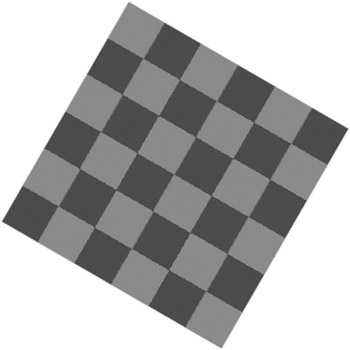Using the SVG translate Function
|
|
|
Using the SVG rotate Function with Checkerboards
Consider the checkerboard pattern rendered in Figure 6.2.

Figure 6.2: Rotated checkerboard with the SVG rotate function.
The SVG document in Listing 6.2 demonstrates how to use the SVG rotate function in order to rotate a checkerboard pattern.
Listing 6.2 rotatedCheckerBoard1.svg
<?xml version="1.0" encoding="iso-8859-1"?> <!DOCTYPE svg PUBLIC "-//W3C//DTD SVG 20001102//EN" "http://www.w3.org/TR/2000/CR-SVG-20001102/DTD/svg-20001102.dtd"> <svg width="800" height="500"> <defs> <pattern width="80" height="80" patternUnits="userSpaceOnUse"> <rect fill="red" x="0" y="0" width="40" height="40"/> <rect fill="blue" x="40" y="0" width="40" height="40"/> <rect fill="blue" x="0" y="40" width="40" height="40"/> <rect fill="red" x="40" y="40" width="40" height="40"/> </pattern> </defs> <g transform="translate(300,50)"> <g transform="rotate(30)"> <rect fill="url(#checkerPattern)" style="stroke:white" x="0" y="0" width="320" height="320"/> </g> </g> </svg>
Remarks
The SVG defs element in Listing 6.2 contains an SVG pattern element that has an id attribute with the value checkerPattern. This pattern consists of an outer square whose length is 80. The inside of the pattern consists of a 2x2 grid of squares whose colors form a checkerboard pattern.
The SVG g element defines a rectangle with width 400 and height 400. This rectangle refers to the pattern checkerPattern defined in the SVG defs element by using the following syntax:
fill="url(#checkerPattern)"
The rotation of the checkerboard pattern is specified in the following SVG fragment:
<g transform="translate(300,50)"> <g transform="rotate(30)"> <rect fill="url(#checkerPattern)" style="stroke:white" x="0" y="0" width="320" height="320"/> </g> </g>
Notice the pair of nested SVG g elements: the outer SVG g element performs a translation of the origin from the point (0,0) to the point (300,50). The inner SVG g element performs a clockwise (not counterclockwise) rotation of 30° of the following rectangle:
<rect fill="url(#checkerPattern)" style="stroke:white" x="0" y="0" width="320" height="320"/>
The rectangle has a fill value that references an SVG pattern element defined in the SVG defs element in Listing 6.2. As you can see, a lot is happening in a very small amount of code!
|
|
|
EAN: 2147483647
Pages: 362